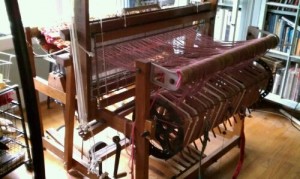My first answer to the question, “How do you make a rag rug loom?” is, “Don’t. Buy one instead.” At least, buy your first loom. Buy, or trade, or borrow, or take a weaving class at your local community college or arts center. Big looms, with moving parts, are serious pieces of craft equipment. Look around at the Weaver’s Friend for pictures of the old rag rug looms, including some of the hand made, unique “barn looms.”
It’s not that you can’t build a loom: it’s simply that you’ll have a much better idea of what you are doing if you use a “real” loom first.
As I write, however, I realize I should back up a little.
What kind of rag rug do you want to make? Some of your choices are:
- Knitted or crocheted
- Made in small squares, on a potholder loom
- Made on a tapestry loom
- Twined
- Woven, warp-faced (the most common form of rag rug, commonly sold cheaply in stores and made in places where labor is very inexpensive)
- Woven, weft-faced (If you can tell the difference between these last two just by reading, you are probably ready to build your own loom)
I made more than 80 rag rugs on a pair of 10″ knitting needles, using no other equipment except a big darning needle to sew up the smaller units. Knitting needles are cheap, compared to even the simplest loom. Some women crochet rugs; at the scale I work, crocheting is too hard on one hand. I prefer to knit because the act of knitting is more balanced between both sides of my body.
On any given day, eBay will list 35-40 potholder loom kits. You can use these to make as many squares as you need, and then sew up the squares to make a rug.
Many tribal rugs, in both North American and world-wide, are made on vertical tapestry looms. I can’t abide the constant over-under hand selection that most of these looms require, but if you have a more contemplative, patient approach to life and craft, these looms aren’t that hard to make.
Twined rag rugs are made on frames which hold the warp, but because both the warp and the weft are often made from the same fiber, the frames do not need to be as strong as a floor loom. Twined Rag Rugs, by Bobbie Irwin, is the book to start with. She discusses all the common forms of twining and how to make your own frame to hold the warp. I plan on getting this book for myself if I ever start twining; for the moment, I’m using my floor loom exclusively. Twined rugs look a lot like stockinette stitch knitting. Some raffia rugs and chairs available on the import market are probably made by twining fiber over a frame.
Finally, we come to the floor looms, ideally, those made for rugs. Rug looms are heavy, solid pieces of equipment, made to take pounding and high tension. In addition, they are often equipped with sectional warp beams that can hold very long warps (100 yards or more) so that the weaver doesn’t lose any time to re-warping. (It takes just as long to put 100 yards on a loom as it does to put 4 yards, and 100 yards = 50 rugs.)

I found this loom on Craig’s List, offered for a trade of a sewing machine I happened to own. As often happens, “free” turned out to cost several hundred dollars of repair parts and new metal; the old hardware had rusted. However, now that I’m following loom sales, I see a goodly supply on both Craig’s List and on various weaver’s guild sales sites around the country. If you have (access to) a truck and are willing to drive a few hundred miles, you can probably find a workable loom for less than $500.
Rag Rug Handbook, by Janet Meany and Paula Pfaff, is the best introduction to rag rug weaving, its social history in the US, and the various looms that women used to weave rag rugs profitably. Many of the looms can be found on the used market today. Unfortunately, this book is out of print. It’s value is confirmed by the used book market, which rarely drops below $60 a copy. If that’s more than your budget will bear, try the interlibrary loan service through your local library. I used this book to help me figure out how to assemble my loom, shown on page 5.
If you still want to build your own loom, or if you already own one loom and are thinking it’s time to build one, I have found two sources with useful plans. The first is Building Craft Equipment: an Illustrated Manual, by A. Jay and Carol W. Abrams. This book has plans for everything from a light box to a potter’s wheel, including textile equipment such as hoop stands, a floor loom, inkle loom, and various weaving accessories like warping boards and rag & stick shuttles. The book is available on the used market for not much money. I’ve looked at the plans for the floor loom, and I’m not completely persuaded that their loom would hold up to the stress I put on it. However, reading about how to make a floor loom of my own is an interesting use of 30 minutes. I’m very glad I saw the description of making my own shuttles, because I might not have recognized making my own rag or stick shuttles was as easy as it’s turn out to be.
The second book about building a loom yourself is called The Loom Book, by Tim Reed. It, too, is out of print, and I have not seen a copy myself. Someone on eBay frequently offers a copy. The promo copy says you can build a loom in 60 hours, using only store-bought lumber. Frankly, 60 hours of my time = income will buy a lot of used loom, and cover the drive time all the way to West Virginia! One of these days, however, I’ll probably get this book simply to see how the loom is made.

